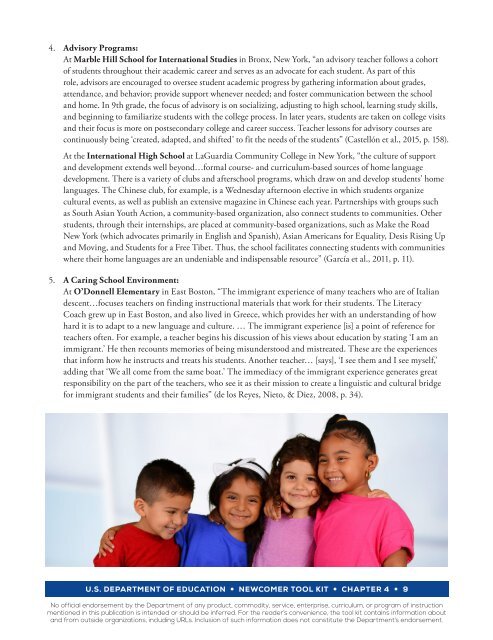NEWCOMER TOOL KIT
xYhe4
xYhe4
Create successful ePaper yourself
Turn your PDF publications into a flip-book with our unique Google optimized e-Paper software.
4. Advisory Programs:<br />
At Marble Hill School for International Studies in Bronx, New York, “an advisory teacher follows a cohort<br />
of students throughout their academic career and serves as an advocate for each student. As part of this<br />
role, advisors are encouraged to oversee student academic progress by gathering information about grades,<br />
attendance, and behavior; provide support whenever needed; and foster communication between the school<br />
and home. In 9th grade, the focus of advisory is on socializing, adjusting to high school, learning study skills,<br />
and beginning to familiarize students with the college process. In later years, students are taken on college visits<br />
and their focus is more on postsecondary college and career success. Teacher lessons for advisory courses are<br />
continuously being ‘created, adapted, and shifted’ to fit the needs of the students” (Castellón et al., 2015, p. 158).<br />
At the International High School at LaGuardia Community College in New York, “the culture of support<br />
and development extends well beyond…formal course- and curriculum-based sources of home language<br />
development. There is a variety of clubs and afterschool programs, which draw on and develop students’ home<br />
languages. The Chinese club, for example, is a Wednesday afternoon elective in which students organize<br />
cultural events, as well as publish an extensive magazine in Chinese each year. Partnerships with groups such<br />
as South Asian Youth Action, a community-based organization, also connect students to communities. Other<br />
students, through their internships, are placed at community-based organizations, such as Make the Road<br />
New York (which advocates primarily in English and Spanish), Asian Americans for Equality, Desis Rising Up<br />
and Moving, and Students for a Free Tibet. Thus, the school facilitates connecting students with communities<br />
where their home languages are an undeniable and indispensable resource” (García et al., 2011, p. 11).<br />
5. A Caring School Environment:<br />
At O’Donnell Elementary in East Boston, “The immigrant experience of many teachers who are of Italian<br />
descent…focuses teachers on finding instructional materials that work for their students. The Literacy<br />
Coach grew up in East Boston, and also lived in Greece, which provides her with an understanding of how<br />
hard it is to adapt to a new language and culture. … The immigrant experience [is] a point of reference for<br />
teachers often. For example, a teacher begins his discussion of his views about education by stating ‘I am an<br />
immigrant.’ He then recounts memories of being misunderstood and mistreated. These are the experiences<br />
that inform how he instructs and treats his students. Another teacher… [says], ‘I see them and I see myself,’<br />
adding that ‘We all come from the same boat.’ The immediacy of the immigrant experience generates great<br />
responsibility on the part of the teachers, who see it as their mission to create a linguistic and cultural bridge<br />
for immigrant students and their families” (de los Reyes, Nieto, & Diez, 2008, p. 34).<br />
U.S. DEPARTMENT OF EDUCATION • <strong>NEWCOMER</strong> <strong>TOOL</strong> <strong>KIT</strong> • CHAPTER 4 • 9<br />
No official endorsement by the Department of any product, commodity, service, enterprise, curriculum, or program of instruction<br />
mentioned in this publication is intended or should be inferred. For the reader’s convenience, the tool kit contains information about<br />
and from outside organizations, including URLs. Inclusion of such information does not constitute the Department’s endorsement.


